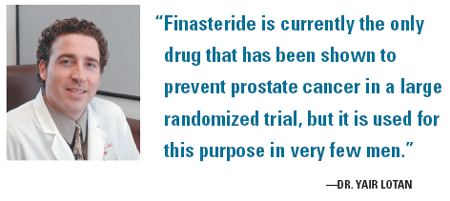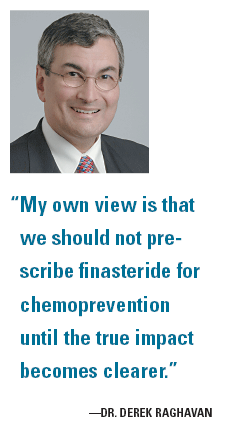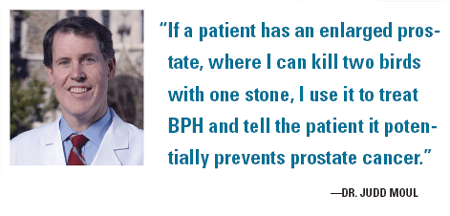Finasteride for chemoprevention of prostate cancer: Is anyone buying it?
A drug proven effective in a large randomized prostate cancer prevention trial is rarely used for that indication. ONI explores the economic and clinical reasons underlying the agent's lack of use.
NCI’s Prostate Cancer Prevention Trial, which randomized more than 18,000 men aged 55 and older to finasteride (Proscar) or placebo for 7 years, showed a 25% reduction in the occurrence of prostate cancer in men taking the 5α-reductase inhibitor and was terminated early based on this encouraging finding (Thompson IM et al: N Engl J Med 349:215-224, 2003).
In the 5 years since this much-publicized study, have urologists applied the data to their own practices? And if not, why not? ONI asked a number of experts to discuss the pros and cons of using finasteride for prostate cancer chemoprevention.
Finasteride inhibits the conversion of testosterone to dihydrotestosterone by the enzyme 5α-reductase, reducing the level of dihydrotestosterone, the most active androgen in the prostate, by 90%.
Finasteride is FDA approved to treat the symptoms of benign prostatic hyperplasia (BPH); it has been shown to shrink the prostate by 20% to 30% and improve urinary flow rates and symptom scores. It is also approved for the treatment of baldness (Propecia).
“Finasteride is currently the only drug that has been shown to prevent prostate cancer in a large randomized trial, but it is used for this purpose in very few men,” said Yair Lotan, MD, of the University of Texas Southwestern Medical Center, Dallas, who has co-authored three studies further analyzing and applying the PCPT data.
Sean Collins, MD, director of minimally invasive urologic oncology at Louisiana State University School of Medicine, New Orleans, agreed that “the vast majority of urologists in this country are not using finasteride for chemoprevention.”
He estimated, based on a survey conducted at the 2007 American Urological Association meeting, that “the use as chemoprevention is in the single digits.Urologists are using finasteride for BPH, of course, and sometimes to relieve anxiety over high PSA levels [when biopsies are negative], but I don’t know any urologists who are using it for chemoprevention,” he said.

Dr. Lotan agreed. “Urologists don’t seem to have a problem giving this drug to men to shrink the prostate. But in the context of cancer prevention, physicians seem more fearful.”
He compared its use to that of tamoxifen in the prevention of breast cancer. Tamoxifen can raise the risk of strokes and endometrial cancer, he said, and “unlike the sexual side effects of finasteride, these adverse effects are not reversible. Tamoxifen is a somewhat dangerous drug and yet it has been given to thousands of women.”
Positive finding not so straightforward
According to Peter Scardino, MD, chair of surgery at Memorial Sloan-Kettering Cancer Center and an expert in prostate cancer, several “disturbing findings” in the original report argue that finasteride should not be prescribed for chemoprevention. He conveyed his opinion in an editorial accompanying the publication of the PCPT results (Scardino PT: N Engl J Med 349:297-299, 2003).
Dr. Scardino noted several factors that muddy the waters of the study’s conclusions. For one, the incidence of cancer in the placebo group was higher than anticipated, as was the proportion of high-grade cancers in the finasteride-treated patients. The latter finding became a key concern of investigators and clinicians, although he acknowledged that it could be an artifact, ie, due to the easier detection of high-grade tumors once the prostate shrinks wtih finasteride.
But he was also concerned that some cancers that were detected were low- to intermediate-grade, clinically localized tumors that may not pose a mortality risk and thus may not warrant expensive preventive efforts.

Derek Raghavan, MD, PhD, chairman and director of the Cleveland Clinic Taussig Cancer Center and ONI Deputy Editor, agreed that the PCPT’s findings were “good news, bad news.”
“At the time the study was published, many of us felt this was a premature communication of the results. The study found that you can reduce the number of new prostate cancers, but, at the same time, men who do get prostate cancer seem to have a worse variant,” said Dr. Raghavan, who is not convinced the drug works to prevent cancer.
An earlier nonrandomized study evaluated finasteride as chemoprevention in 52 men with elevated PSA levels and found no benefit in reducing the proliferation index or in preventing tumors, he noted. In fact, cancer was more likely in the finasteride-treated patients (Cote RJ et al: Br J Cancer 78:413-418, 1998).
In his editorial, Dr. Scardino offered a biological explanation for the emergence of high-grade tumors: “By reducing intraprostatic androgen levels, finasteride may have created an environment in which high-grade cancers that were less dependent on androgens for their growth had a competitive advantage.” Nevertheless, he added, recent data have shown that the performance characteristics of PSA actually improve with finasteride therapy.
Dr. Raghavan said he is less inclined to believe that finasteride is altering the biology of the cancer and more inclined to think that finasteride may be reducing the prostate, “making it easier to see the cancer foci.” Two recent analyses of the PCPT results came to a similar conclusion (J Natl Cancer Inst 99:1366-1374; 1375-1383, 2007).
This question is one being evaluated by Dr. Collins and his colleagues at LSU. They are examining prostatectomy samples to assess for biological changes after treatment with 5α-reductase inhibitors.
“We want to see if the affinity for the androgen receptor changes after being on these medications, and, if so, if this might be related to the biology of prostate cancer,” Dr. Collins told ONI.
Quality of life counts
Dr. Lotan acknowledged these complexities and commented, “This all makes for a difficult topic. We have published three papers on chemoprevention with finasteride, and I am not sure we have clarified the issue substantially,” he said.
But having analyzed the PCPT data from various angles, Dr. Lotan views the situation more broadly. The widespread use of any preventive strategy, he said, should result in a survival benefit with minimal morbidity.
Finasteride’s principal side effects relate to reversible sexual dysfunction and affect only 5% of men. And the drug improves quality of life on many levels, not just by alleviating the urinary symptoms of BPH. In terms of cancer prevention, the clinical relevance (or irrelevance) of any tumor is unknown at the time of diagnosis and is always of great concern to patients. The prevention of such anxiety is a quality-of-life benefit, he pointed out.
“There are problems if you look at cost-effectiveness alone. It is very important to look at quality of life,” Dr. Lotan emphasized. “Some critics of finasteride argue that the majority of cancers that are detected are Gleason score 6 and clinically insignificant-they say, ‘who cares?’ But look at the quality-of-life issues. For our patients, having cancer and being told that you do not need treatment because the cancer probably will not kill you is not like living with a mole on your body! It’s an anxiety-provoking situation that affects daily life. Most patients say, ‘I can’t live with this cancer. Take it out!’”
Therefore, avoiding a diagnosis of cancer, even one of low grade, is important, as it improves quality of life, avoids the costs and side effects of unnecessary treatment for clinically irrelevant tumors, and avoids suffering, he concluded.
Cost of prevention
Such prevention does not come cheaply. Dr. Lotan and his co-authors factored in the quality-of-life benefits and other theoretical factors to determine the cost-effectiveness of chemoprevention with finasteride. They determined that for a 50-year-old man taking finasteride for 25 years, each quality-adjusted life year (QALY) would cost almost $123,000, well above the generally accepted threshold of $50,000 to $100,000.
Assuming that finasteride does not increase the risk of high-grade prostate cancer, the QALY cost drops to $112,062. Using a less expensive chemopreventive agent could potentially reduce the QALY cost to approximately $50,000 (Svatek RS et al: Cancer 112:1058-1065, 2008).
Other cost-related issues also impede widespread adoption, Dr. Lotan said. The $60 per month cost is not covered by insurance carriers, who only cover finasteride for its approved BPH indication.
“For an expensive drug to be used possibly for decades, naturally, insurance companies are not going to be excited about paying for this,” Dr. Lotan noted.

Furthermore, since finasteride is now generic, there is no incentive for a company to seek FDA approval for chemoprevention or for drug representatives to promote it to physicians, added Judd Moul, MD, chief of urologic surgery, Duke University Medical Center.
“I am something of a fan of finasteride [for chemoprevention], but it hasn’t caught on as much as perhaps NCI and the study’s investigators thought it would,” Dr. Moul said. “The drug went off patent soon after this study was published, so it was not FDA approved for this purpose and the drug isn’t detailed to the physician for this indication.”
This situation regarding chemoprevention could change, however, as ongoing studies come to fruition, especially the REDUCE trial, which is evaluating chemoprevention with dutasteride (Avodart), a newer and more expensive drug that also has benefits for BPH. Confirmatory studies with this similar agent, and FDA approval of it, might lead to greater use of chemoprevention, he predicted.
In addition, the SELECT trial is evaluating a nonprescription regimen of selenium and vitamin E for chemoprevention, which could certainly alter the cost-effectiveness picture of chemoprevention for prostate cancer.
Targeted population
“My position is that I have not found enough data to make me start using finasteride for chemoprevention,” said Dr. Collins of LSU.
But to some clinicians, there are subsets of patients in whom finasteride seems justified. Dr. Lotan suggested targeting the drug to patients at high risk of developing prostate cancer.
Dr. Moul noted, “If a patient has an enlarged prostate or urinary symptoms, where I can kill two birds with one stone, I use it to treat BPH and tell them it potentially prevents prostate cancer as well.”
For protecting men deemed at high risk, Dr. Moul finds the decision more complicated: “I debate this in my mind all the time, for example, whether to prescribe this to the 40-year-old African-American with a family history of prostate cancer. The problem is that PCPT started enrollment at age 55, so there is no evidence-based data on younger patients.”
In the younger man, he is also concerned about the potential, while slight, for sexual side effects, but he noted that this is hard to sort out. “You give men a pill of any kind, and they will likely report an effect on their sexual function,” he said. “There’s a huge placebo effect.”
Dr. Moul emphasized that the most common use of finasteride in his practice is for men aged 55 and older with an enlarged prostate and urinary symptoms, and an elevated PSA and negative prostate biopsy. “They are worried. I am treating their BPH, lowering their PSA, and, hopefully, decreasing their risk of developing prostate cancer. And if they happen also to be bald,” he added, “I’m killing three or four birds with one stone.”
For most clinicians, the issue remains unresolved. “We are left in a quandary,” Dr. Raghavan said. “What do we do with this information? My own view is that we should not prescribe finasteride for chemoprevention until the true impact becomes clearer. I believe clinical trials will determine whether this is a step forward or not.”
PRO
- In the PCPT, prostate canceroccurrence was reduced by 25% with use of finasteride.
- By preventing prostate cancers, finasteride prevents the anxiety that accompanies a prostate cancer diagnosis, thus improving quality of life.
- If a patient has symptomatic BPH, finasteride can be prescribed both to reduce urinary symptoms and potentially prevent prostate cancer.
CON
- In the PCPT, men who received finasteride had a reduced incidence of prostate cancer but the prostate cancers that developed were more likely to be high grade.
- In the PCPT, 5% of men reported sexual complaints, including reduced volume of ejaculate, erectile dysfunction, loss of libido, and gynecomastia.
- The cost per QALY of prostate cancer prevention with finasteride is above the generally accepted threshold.
Newsletter
Stay up to date on recent advances in the multidisciplinary approach to cancer.
Navigating Treatment Intensification in Metastatic Hormone-Sensitive Prostate Cancer
A patient case of a 50-year-old man with hormone-sensitive prostate cancer sparked a debate among oncologists regarding the best course of action.